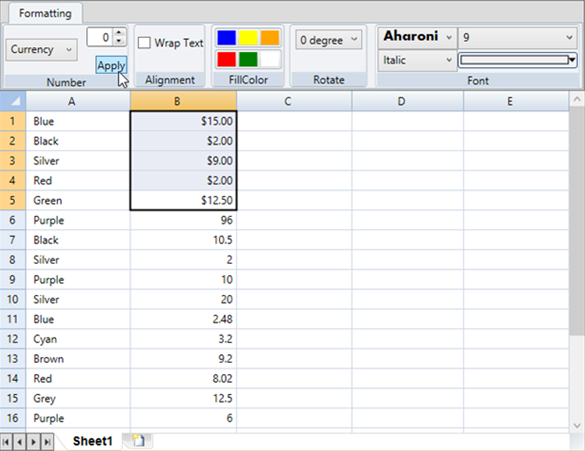Number Formatting
FlexSheet for WPF provides various options to display numbers in different number formats wherein you have the following categories to choose from:
- General
- Number
- Currency
- Percentage
- Scientific
By default, General category is selected in C1FlexSheet. General category does not have any special rule of formatting. You can change the number formatting of the cells to number, decimal, currency, percentage or scientific format. For example, to create a worksheet for your monthly or yearly business budgets, you can show the monetary values in Currency number format.
To format numbers in your C1FlexSheet worksheet, follow the steps given below:
Add C1FlexSheet control and C1Toolbar to your application.
Add a ComboBox, NumericBox and a button to the ToolBar using the following code:
<ComboBox x:Name="formatList" ItemsSource="{Binding NumberFormats}" Width="80" DisplayMemberPath="Name" Height="25" SelectedValue="{Binding SelectedFormat, Mode=TwoWay}" SelectionChanged="formatList_SelectionChanged"></ComboBox> <c1:C1NumericBox x:Name="decimalPlacesBox" Minimum="0" Margin="10,0,0,0" ValueChanged="decimalPlacesBox_ValueChanged"></c1:C1NumericBox> <Button x:Name="numberButton" Content="Apply" Click="numberButton_Click" Margin="20,10,0,0"></Button>Create a class named NumberFormat which inherits INotifyPropertyChanged interface. NumberFormat class contains SelectedFormat property to get and set the selected format of numbers.
Add the following code in Code view to set the SelectedFormat property of NumberFormat class: vbnet
Public Property SelectedFormat() As NumberFormat Get Return _selectedFormat End Get Set _selectedFormat = value End Set End Propertycsharp
public NumberFormat SelectedFormat { get { return _selectedFormat; } set { _selectedFormat = value; } }Also, add the following code in Code view to set the NumberFormats property of ObservableCollection data collection of Number type:
vbnet
Public Property NumberFormats() As ObservableCollection(Of NumberFormat) Get Return _numberFormats End Get Set _numberFormats = value End Set End Propertycsharp
public ObservableCollection<NumberFormat> NumberFormats { get { return _numberFormats; } set { _numberFormats = value; } }Define InitializeNumberFormats() method to specify the formats that will be used to change the number formatting: vbnet
Public Sub InitializeNumberFormats() NumberFormats = New ObservableCollection(Of NumberFormat)() Dim generalFormat As New NumberFormat() generalFormat.Name = "General" generalFormat.Format = "G" NumberFormats.Add(generalFormat) Dim numberFormat As New NumberFormat() numberFormat.Name = "Number" numberFormat.Format = "N" NumberFormats.Add(numberFormat) Dim currencyFormat As New NumberFormat() currencyFormat.Name = "Currency" currencyFormat.Format = "C" NumberFormats.Add(currencyFormat) Dim percentFormat As New NumberFormat() percentFormat.Name = "Percentage" percentFormat.Format = "P" NumberFormats.Add(percentFormat) Dim exponentialFormat As New NumberFormat() exponentialFormat.Name = "Scientific" exponentialFormat.Format = "E" NumberFormats.Add(exponentialFormat) SelectedFormat = generalFormat End Subcsharp
public void InitializeNumberFormats() { NumberFormats = new ObservableCollection<NumberFormat>(); NumberFormat generalFormat = new NumberFormat(); generalFormat.Name = "General"; generalFormat.Format = "G"; NumberFormats.Add(generalFormat); NumberFormat numberFormat = new NumberFormat(); numberFormat.Name = "Number"; numberFormat.Format = "N"; NumberFormats.Add(numberFormat); NumberFormat currencyFormat = new NumberFormat(); currencyFormat.Name = "Currency"; currencyFormat.Format = "C"; NumberFormats.Add(currencyFormat); NumberFormat percentFormat = new NumberFormat(); percentFormat.Name = "Percentage"; percentFormat.Format = "P"; NumberFormats.Add(percentFormat); NumberFormat exponentialFormat = new NumberFormat(); exponentialFormat.Name = "Scientific"; exponentialFormat.Format = "E"; NumberFormats.Add(exponentialFormat); SelectedFormat = generalFormat; }Add the following code to the FormatList ComboBox that monitors the selection and sends information to the console to show the list of available number formats when the selection changes: vbnet
Dim selectedFormat__1 = TryCast(e.AddedItems(0), NumberFormat) Select Case selectedFormat__1.Name Case "General" decimalPlacesBox.Visibility = System.Windows.Visibility.Collapsed decimalPlacesBox.Value = 0 SelectedFormat.Format = selectedFormat__1.Format Exit Select Case "Number" decimalPlacesBox.Visibility = System.Windows.Visibility.Visible SelectedFormat.Format = selectedFormat__1.Format Exit Select Case "Currency" decimalPlacesBox.Visibility = System.Windows.Visibility.Visible SelectedFormat.Format = selectedFormat__1.Format Exit Select Case "Percentage" decimalPlacesBox.Visibility = System.Windows.Visibility.Visible SelectedFormat.Format = selectedFormat__1.Format Exit Select Case "Scientific" decimalPlacesBox.Visibility = System.Windows.Visibility.Visible SelectedFormat.Format = selectedFormat__1.Format Exit Select End Selectcsharp
var selectedFormat = e.AddedItems[0] as NumberFormat; switch (selectedFormat.Name) { case "General": decimalPlacesBox.Visibility = System.Windows.Visibility.Collapsed; decimalPlacesBox.Value = 0; SelectedFormat.Format = selectedFormat.Format; break; case "Number": decimalPlacesBox.Visibility = System.Windows.Visibility.Visible; SelectedFormat.Format = selectedFormat.Format; break; case "Currency": decimalPlacesBox.Visibility = System.Windows.Visibility.Visible; SelectedFormat.Format = selectedFormat.Format; break; case "Percentage": decimalPlacesBox.Visibility = System.Windows.Visibility.Visible; SelectedFormat.Format = selectedFormat.Format; break; case "Scientific": decimalPlacesBox.Visibility = System.Windows.Visibility.Visible; SelectedFormat.Format = selectedFormat.Format; break; }Add the given code to avail the selection of decimal places while changing the number format: vbnet
SelectedFormat.DecimalPlaces = CInt(e.NewValue)csharp
SelectedFormat.DecimalPlaces = (int)e.NewValue;Add this code on the click event of the button, numberButton in our case, to apply the selected format in the previous step: vbnet
Dim cellrange = flex.Selection.Cells For Each rng As var In cellrange If rng.IsValid Then Dim row = TryCast(flex.Rows(rng.Row), ExcelRow) Dim col = flex.Columns(rng.Column) Dim excelCellStyle As New ExcelCellStyle() If row IsNot Nothing Then Dim cs = TryCast(row.GetCellStyle(col), ExcelCellStyle) If cs IsNot Nothing Then excelCellStyle = cs End If End If 'set selected Number formatting on cells excelCellStyle.Format = SelectedFormat.Format + SelectedFormat.DecimalPlaces row.SetCellStyle(col, excelCellStyle) flex.Invalidate(rng) End If Nextcsharp
var cellrange = flex.Selection.Cells; foreach (var rng in cellrange) { if (rng.IsValid) { var row = flex.Rows[rng.Row] as ExcelRow; var col = flex.Columns[rng.Column]; ExcelCellStyle excelCellStyle = new ExcelCellStyle(); if (row != null) { var cs = row.GetCellStyle(col) as ExcelCellStyle; if (cs != null) excelCellStyle = cs; } //set selected Number formatting on cells excelCellStyle.Format = SelectedFormat.Format + SelectedFormat.DecimalPlaces; row.SetCellStyle(col, excelCellStyle); flex.Invalidate(rng); } }Select the cells with numeric data to change the number format.
Select a category from the available category list in Number tab.
Set the decimal places if required.Click Apply button to see the applied number format.
On applying number format, FlexSheet control looks similar to the image given below:
In the above image, the selected number format is Currency.


